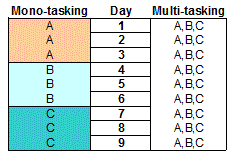For more than a decade Tasmanian public education has been in a state of continuous structural and policy change. Given the disappointing outcomes this is likely to continue. Well intentioned initiatives have been largely top-down, one-size-fits-all approaches that ultimately require the compliance of staff at all levels. That is, governments and senior officers have attempted to
drive improvements from on high by providing schools and staff with the answers while failing to properly understand the questions - classic MBO (management by objectives, circa 1960s).
To be fair, most initiatives have been rational, "best practice" and/or "evidence based" meaning that the initiatives appear reasonable and have been successful elsewhere. However, initiatives have to occur in a context and each situation (student, teacher, school, family, community...) involves a different context: each with its own history, needs, hopes, culture, resources...
In engineering, "best practices" are readily transferable - cause and effect are consistent over place and time and the outcomes are predictable The same cannot be said for human endeavours such as education. Education is a complex endeavour, not subject to consistent natural laws. In complex systems similar initiatives can have very different outcomes in different places - like the weather, starting conditions (the initial context) make can a huge difference.
Schools, classes, education departments... are all complex (adaptive) systems. They are not factories that can be controlled in a mechanical way - the processes involved are not based on natural laws. They are not changed by flicking switches and turning dials. Rather they are the
sum total of the everyday interactions of their various parts (the people, policies, rules, working relationships, resources, opportunities... and the context). What happens emerges over time from the all interactions of the parts of the system.
Key questions
What is the purpose of our systems?
- We create systems in order to achieve what is desirable.
What are the underlying mechanisms involved?
- In context, the people involved continually construct (and reconstruct) their knowledge, (inter)actions, arrangements and relationships in ways that will (ideally) help them achieve of what is desirable.
What design principles might apply?
At all levels, systems should enable the achievement of their purposes easily and well.
Systems should also incorporate their own ongoing
improvement strategies.
Due diligence should be undertaken before implementing a major proposal
Implications
The implications are that top-down initiatives need to be complemented by matching responses throughout the system. To be successful initiatives need to be coherent and useful. All this sounds a bit cumbersome, so why not allow people at the top make the decisions to drive the achievement of what is desirable?
When systems try to drive detailed change they often end up requiring compliance and this is usually counter-productive and difficult to sustain. When system requirements conflict with the immediate needs of students, schools and staff often face a dilemma. Such dilemmas are best understood as opportunities for learning and for system improvement. If such a dilemma is resolved by requiring compliance there will be more losers than winners, especially in the longer term.
The alternative is for the system to focus on providing enablers (
purposes, principles, tools...) that will
nurture the emergence of what is desirable. People want to do well and to contribute - schools and their staff care about the success and well-being of their students. The system needs to be judged by the extent to which it enables all to achieve success and well-being now and it the future.

